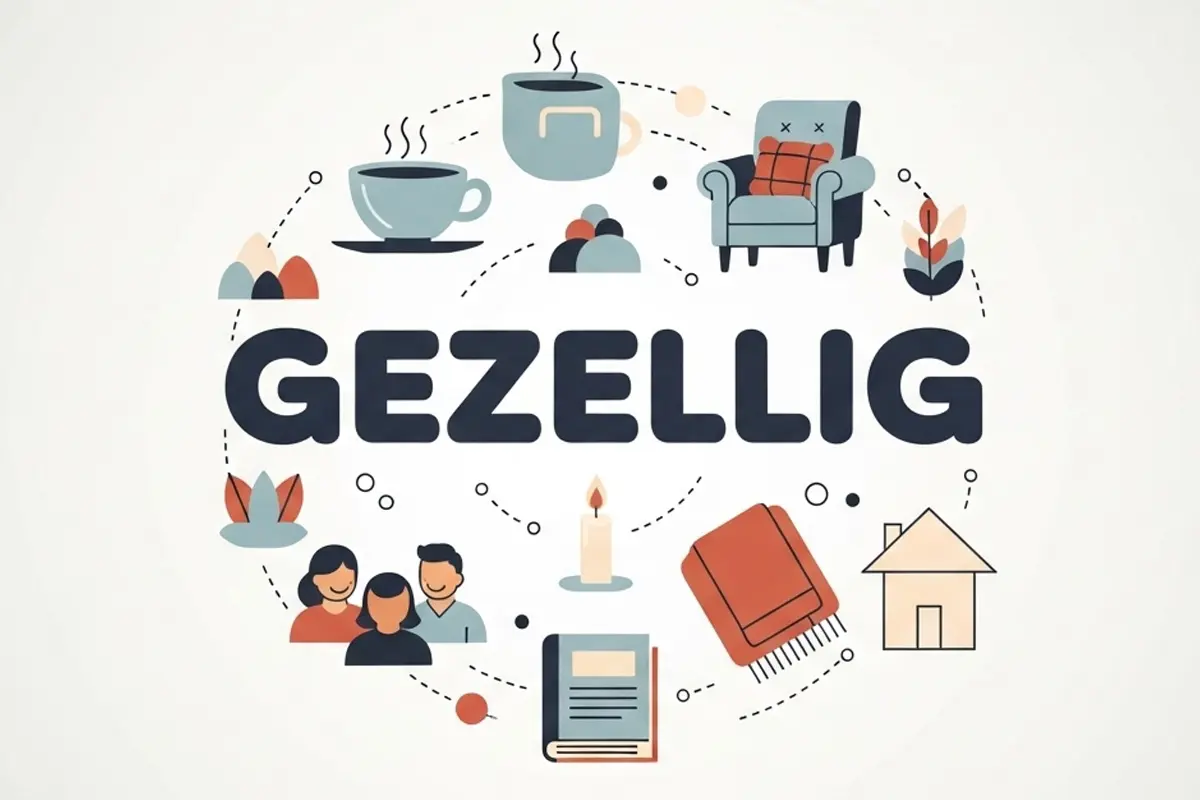
TL;DR
- Gezellig is one of the most beloved Dutch words, meaning warm, cozy, and friendly.
- It captures a feeling of togetherness, comfort, and belonging — not just physical coziness.
- There’s no exact English translation, but it’s close to “cozy,” “pleasant,” or “heartwarming.”
- The noun form gezelligheid means coziness or conviviality.
- It reflects the core of Dutch social life and culture — simple joys shared with others.
What Does “Gezellig” Mean in Dutch?
The word “gezellig” (pronounced ɣəˈzɛləx or khuh-ZEH-likh) is one of the most untranslatable words in the Dutch language.
At its heart, gezellig describes a warm, friendly atmosphere or moment — the kind of comfort that comes from being together, feeling accepted, and enjoying simple pleasures.
It can describe:
- A room that feels inviting.
- A meal shared among friends.
- A person who makes others feel at ease.
- Even an evening that felt just right.
So when a Dutch person says, “Het was gezellig!” it means It was such a great, cozy time! — but with an emotional depth English can’t fully capture.
Why “Gezellig” Defines Dutch Culture?
The concept of gezelligheid (the noun form) goes beyond language — it’s a cultural value.
The Dutch see social connection and warmth as essential to a happy life, even in a country known for rainy weather and reserved personalities.
Here’s what gezelligheid looks like in daily life:
| Setting | Example | Why It’s Gezellig |
|---|---|---|
| At home | Candles lit, music soft, coffee with friends | It feels safe, warm, and welcoming |
| In cafés | Laughing with people at a brown café | Shared joy and comfort |
| In offices | Small talk with colleagues | Builds human connection |
| In cities | Christmas markets, street lights | Communal atmosphere |
It’s a way of life — one that prioritizes connection over perfection and presence over productivity.
💬 A popular Dutch saying is “Doe maar gewoon, dan doe je al gek genoeg.” (Just act normal, that’s crazy enough.)
And gezelligheid fits perfectly with this down-to-earth attitude.
Examples of How to Use “Gezellig”
Here are a few real examples to help you understand the different shades of meaning:
| Dutch Sentence | English Translation | Meaning |
|---|---|---|
| Het was gezellig gisteravond! | It was fun last night! | Describes a pleasant evening |
| Wat een gezellige kamer! | What a cozy room! | Compliment on ambiance |
| Ze is zo gezellig om mee te praten. | She’s so nice to talk to. | Refers to someone’s personality |
| Laten we gezellig samen eten. | Let’s eat together nicely. | Emphasizes togetherness |
Whether it’s about a person, place, or experience, gezellig always signals something emotionally warm and socially positive.
How to Pronounce “Gezellig” in Dutch?
Pronouncing gezellig can be tricky for English speakers because of the Dutch “g” sound.
Here’s a simple guide:
| Letter | Dutch Sound | Approx. English Equivalent |
|---|---|---|
| G | A throaty kh sound (like in Scottish “loch”) | kh |
| Z | Soft z, like “buzz” | z |
| LLIG | Pronounced l-ikh | lickh with soft ending |
So it sounds roughly like: “khuh-ZEH-likh.”
Try saying it with a smile — because gezellig isn’t just a sound, it’s a feeling.
Gezellig vs. Cozy — Why They’re Not the Same
Many English articles translate gezellig as cozy, but that’s only part of the picture.
While “cozy” refers to physical comfort, gezellig includes emotional and social warmth.
| English Word | Dutch Equivalent | Difference |
|---|---|---|
| Cozy | Gezellig | Cozy = physical comfort; Gezellig = emotional connection |
| Fun | Leuk | Leuk is general fun, gezellig is shared joy |
| Nice | Aardig | Aardig = polite; gezellig = friendly and engaging |
| Homely | Gezellig | “Homely” sounds negative in English, but gezellig is positive |
So a “gezellige avond” (cozy evening) isn’t just about the sofa and candles — it’s about the laughter, the presence, and the mood.
The Spirit of “Gezelligheid”
Gezelligheid is a noun derived from gezellig and captures the state of being cozy and together.
It’s often used to describe a place, event, or feeling that brings people together.
Example:
“De gezelligheid van het café maakt me blij.”
The coziness of the café makes me happy.
In Dutch society, gezelligheid appears everywhere — in how people decorate their homes (with soft lighting, simple furniture, and plants), how they plan evenings (borrels, or informal drinks), and even in how they talk about work-life balance.
The Emotional Layer of Gezellig
At its core, gezellig is about belonging.
It’s the opposite of loneliness — it’s shared comfort, quiet laughter, a warm glow after the rain.
That’s why tourists often notice how Dutch cafés, family dinners, and social events feel especially intimate and welcoming.
It’s not fancy or loud — it’s sincere, relaxed, and human.
FAQ: Gezellig Meaning in Dutch
Q: What does “gezellig” literally mean?
A: Literally, it means something like “sociable” or “pleasant,” but it represents a deeper sense of warmth and connection.
Q: Can a person be called “gezellig”?
A: Yes! It means they’re enjoyable to be around — friendly, kind, and fun.
Q: Is “gezellig” positive or negative?
A: Always positive. It’s one of the happiest Dutch words.
Q: What’s the noun form of “gezellig”?
A: “Gezelligheid” — meaning coziness or conviviality.
Conclusion
The gezellig meaning in Dutch reveals a cultural truth: happiness often lives in small, shared moments.
It’s not about luxury — it’s about connection. A candlelit evening, a good chat, or a rainy afternoon spent with friends can all be gezellig.
So next time you visit the Netherlands, remember that being gezellig isn’t just a word — it’s a way of life.
Continue exploring Dutch expressions with: